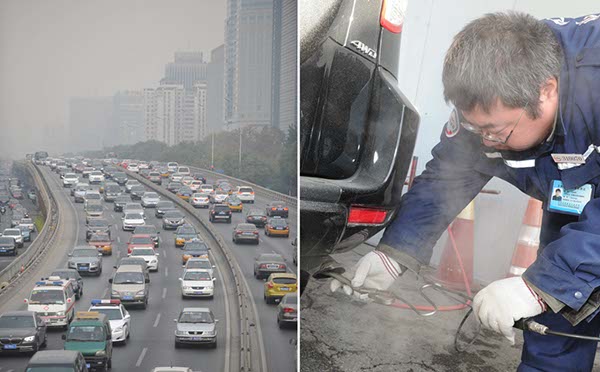 Left: Traffic is slow during a smoggy day in November on the Second Ring Road in Beijing. Right: A worker examines emissions from a car to ensure it complies with the standards. [Photo/Xinhua] |
Although scientists have not agreed on an exact percentage of vehicle exhausts' contribution to fine particulate matters in big cities, they do agree it is a major source of pollution.
A recent study that said automobile exhaust accounts for less than 4 percent of Beijing fine particles triggered public concern as policies restricting vehicle purchase and use are being promoted nationwide.
Yet, the Chinese Academy of Sciences, which released the study, admitted later the figure was "substantially undervalued" as scientists are still unable to clearly distinguish the sources of some substances in PM2.5 - particulate matter with a diameter of 2.5 micrometers or less.
The academy's admission caused public confusion over vehicles' actual contribution to Beijing's air pollution, which ranges from 10 to 50 percent, depending on who you ask.
The best-known figure is 22.2 percent, quoted by the Beijing Environmental Protection Bureau in June.
Another study by the Chinese Academy of Sciences in January singled out automobiles as the biggest PM2.5 contributor in Beijing, accounting for about 25 percent.
Other major studies last year included one from Peking University, which concluded automobile emissions were responsible for a sixth of the PM2.5 pollution, while the Chinese Academy of Meteorological Sciences said 23 percent.
"The differing results mainly came from the variability of PM2.5 distribution in time and space, the methodology adopted, and the subjective factors of the researchers," said He Hong, a chief scientist with the academy.
According to Zhuang Guoshun, a professor at Fudan University's Environmental Science and Engineering Department, sulfate from coal-burning, organic hydrocarbon, nitrogen oxide and black carbon are all major substances that cause decreased visibility in smog.
All of these substances except the sulfate, he added, are related to vehicle emissions.
On Jan 2, the Beijing Environmental Protection Bureau released figures gathered from monitoring stations near heavy traffic areas that showed fine particulate matter was 15 percent higher in those areas than the city average.
Experts have reached a consensus on car emissions' significant contribution to PM2.5 but they have not agreed on measures to tackle the issue, said Yue Xin, an associate researcher at the Chinese Research Academy of Environmental Sciences.
He said he does not agree with the current restrictions on purchasing motor vehicles adopted by many cities and added that raising usage costs would be more effective.
"Raising usage costs on automobiles, such as charging higher prices for diesel fuel and parking, is a fairer method than simply restricting purchases," he said. "It helps distinguish car users' real demand and gives people the freedom to use a car when they really need to."
